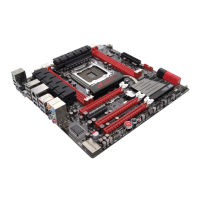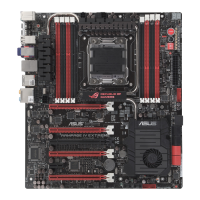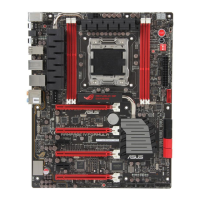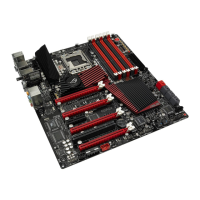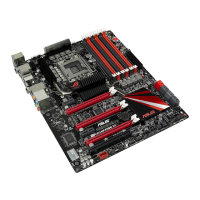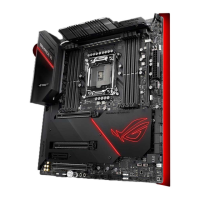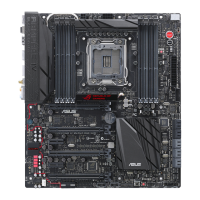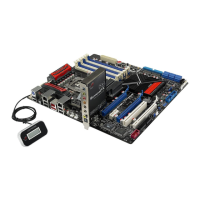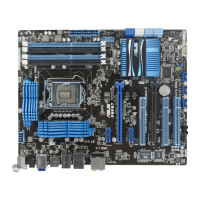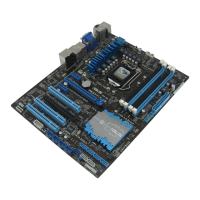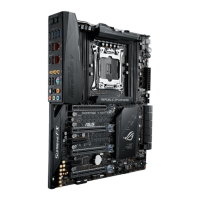
Do you have a question about the Asus RAMPAGE V EDITION 10 and is the answer not in the manual?
| Chipset | Intel X99 |
|---|---|
| CPU Socket | LGA 2011-v3 |
| Memory Slots | 8 |
| Memory Type | DDR4 |
| Maximum Memory | 128GB |
| SATA 6Gb/s | Yes |
| SATA 6Gb/s Ports | 10 |
| M.2 Slots | 1 |
| U.2 Ports | 1 |
| USB 3.1 Ports (Rear) | 2 |
| USB 3.0 Ports (Rear) | 8 |
| Audio | ROG SupremeFX 2015 8-Channel High Definition Audio CODEC |
| RAID Support | 0, 1, 5, 10 |
| Memory Speed | DDR4 3333(O.C.)/3200(O.C.)/3000(O.C.)/2800(O.C.)/2666(O.C.)/2400(O.C.)/2133 MHz |
| PCI Express x1 Slots | 1 |
| LAN | Intel I218-V, Intel I211-AT |
| PCIe Slots | 4 x PCIe 3.0/2.0 x16 (x16, x16/x16, x16/x8/x8 or x16/x8/x8/x8 mode(s)) 1 x PCIe 2.0 x4 (max at x4 mode) 1 x PCIe 2.0 x1 |
Essential precautions before installing motherboard components or changing settings.
Diagram and identification of motherboard components, connectors, and slots.
Details about the LGA2011-v3 CPU socket and installation precautions.
Information on DDR4 DIMM slots and how to install memory modules.
Details and configuration options for PCIe 3.0 and 2.0 expansion slots.
Explanation of onboard buttons like Power-on, Reset, and MemOK! for system control.
Description of BIOS LEDs, PCIe lane LEDs, and Q-Code LED indicators.
Details on the LN2 Mode jumper and its function for cold-boot bug remedy.
Information on SATA, ROG Extension, Thermal sensor, USB, TPM, and Thunderbolt connectors.
Explanation of the ROG ProbeIt feature for detecting system voltage and OC settings.
Step-by-step guide to installing the motherboard into the PC chassis.
Detailed instructions for installing the CPU using the CPU Installation Tool.
Procedure for installing the CPU heatsink and fan assembly.
Guide on how to install and remove DIMM memory modules.
Instructions for connecting ATX power supply plugs to the motherboard.
Connecting SATA hard drives and optical drives to the motherboard.
Connecting front panel audio, USB 2.0, and USB 3.0 connectors.
Steps for installing PCIe x16 and PCIe x1 expansion cards.
Guide for installing the SupremeFX Hi-Fi audio panel.
Instructions for installing the ASUS 3T3R dual band Wi-Fi antenna.
Explains how to update the BIOS using USB BIOS Flashback.
Identification and description of rear panel connectors and ports.
Diagrams for connecting headphones, microphones, and speaker systems.
Connecting headphones and microphones to the SupremeFX Hi-Fi audio I/O.
Steps for the first-time system startup and POST checks, including BIOS beep codes.
Methods for turning off or putting the system into sleep mode.
Overview of ASUS UEFI BIOS, its features, and recommended settings.
Guide to navigating and using the BIOS Setup program in EZ and Advanced modes.
Introduction to the EZ Mode for basic system information and settings.
Detailed explanation of the Advanced Mode's menus and configuration options.
How to configure CPU and chassis fan speeds using QFan Control.
Using EZ Tuning Wizard for automatic overclocking and RAID setup.
How to save and access frequently used BIOS items in My Favorites.
Overview of system information and basic settings available in the Main menu.
Configuration options for overclocking-related items like BCLK and DRAM frequency.
Configuration options for CPU, PCH, USB, and other system devices.
Configuring CPU-related information and power management features.
Configuring PCI Express slots and SATA devices.
Managing SATA devices, mode selection, and S.M.A.R.T. status.
Configuring System Agent related features.
Changing USB-related features and port controls.
Configuring platform-related features.
Enabling or disabling onboard audio, USB 3.1, RGB LEDs, Bluetooth, and LAN.
Configuring APM settings for power saving and ErP readiness.
Configuring network stack features.
Settings for ROG Effects, including RGB LED lighting color and effects.
Displaying SMART information for connected storage devices.
Monitoring system temperature, power status, and fan settings.
Configuring system boot options, including Fast Boot and boot device priority.
Accessing BIOS utilities like GPU Post, EZ Flash 3, and Secure Erase.
Displays installed graphics cards and suggested configurations for performance.
Procedure for updating BIOS using EZ Flash 3 utility via USB or internet.
Guide on how to securely erase SSD contents for performance restoration.
Storing and loading multiple BIOS settings and overclocking profiles.
Viewing DRAM SPD information.
Options for loading default settings, saving changes, or discarding changes and exiting.
Instructions and utilities for updating the motherboard BIOS safely.
Updating BIOS from within the Windows environment using EZ Update.
Step-by-step guide to updating BIOS using the ASUS EZ Flash 3 utility.
How to recover a corrupted BIOS using the ASUS CrashFree BIOS 3 utility.
Overview of supported RAID configurations (RAID 0, 1, 10, 5) and driver disk creation.
Definitions and benefits of RAID 0, RAID 1, RAID 5, and RAID 10 configurations.
Steps for installing SATA hard disks for RAID configuration.
Procedure to enter and configure Intel® Rapid Storage Technology in UEFI BIOS.
Navigating the Intel® Rapid Storage Technology Option ROM utility for RAID management.
Steps to create a RAID driver disk for Windows OS installation.
FCC, Canadian, Japanese, and Korean compliance statements and warnings.
FCC statement regarding device operation and interference.
Compliance statement for Canadian ICES-003 and RSS 210.
Statement on digital apparatus meeting Class B limits for radio noise.
VCCI statement for Japan compliance.
Warning statement for Korean compliance.
Information on REACH, RF exposure, wireless use, and Bluetooth compliance.
Information on REACH compliance and proper disposal of electronic products.
Notices regarding CE, Wireless Radio Use, RF Exposure, and Bluetooth compliance.
Statement of compliance with EU RF Exposure Requirements and R&TTE Directive.
Restriction on indoor use for specific Wi-Fi frequency bands.
Advisory on minimizing human contact with wireless equipment.
FCC conditions for co-location of antennas with transmitters.
Statement on Bluetooth device meeting Canadian interference regulations.
Wireless statements for Taiwan and Japan RF equipment.
Wireless statement regarding 5GHz band usage in Taiwan.
Statement on RF equipment usage in Japan according to radio law.
Software license, product warranty, contact information, and conformity.
License terms for Google™ software included with the product.
Information about the product warranty, coverage, and ASUS's repair/replacement policy.
Contact details for ASUS technical support and customer service.
Formal declaration of product conformity with FCC specifications.

